1. Biography
Jean Simmons's life began in London, characterized by a unique family background and early aspirations that unexpectedly led her into the world of acting. Her early career saw her rapid ascent in British cinema, setting the stage for her future international stardom.
1.1. Early Life and Education
Jean Merilyn Simmons was born on 31 January 1929, in Islington, London, England. She was the youngest of four children born to Charles Simmons and Winifred Ada (née Loveland). Her father, Charles Simmons, was a notable figure who had achieved a bronze medal in gymnastics at the 1912 Summer Olympics. He later worked as a physical education teacher. During World War II, the Simmons family was evacuated to Winscombe, Somerset. While there, her father taught briefly at Sidcot School. It was during this period that Jean, following her eldest sister, first performed on a village stage, singing popular songs such as "Daddy Wouldn't Buy Me a Bow Wow". At this time, her primary ambition was to become an acrobatic dancer. Upon returning to London, Simmons enrolled in the Aida Foster stage school, focusing on dance.
q=Islington, London|position=left
1.2. Early Career and British Stardom
Simmons's entry into acting was unexpected; she was spotted by director Val Guest while at the Aida Foster School of Dance. Guest cast her in a significant role as the sister of Margaret Lockwood's character in the 1944 film Give Us the Moon. This initial opportunity paved the way for small but consistent roles in several other films, including Mr. Emmanuel (1944), Kiss the Bride Goodbye (1945), Meet Sexton Blake (1945), and the popular The Way to the Stars (1945), as well as the short film Sports Day (1945).
A pivotal early role was as a harpist in the high-profile 1945 film Caesar and Cleopatra, produced by Gabriel Pascal and starring Vivien Leigh. This film also featured her future husband, Stewart Granger. Pascal recognized Simmons's potential and, in 1945, signed her to a seven-year contract with the J. Arthur Rank Organisation, marking a significant step in her professional development.
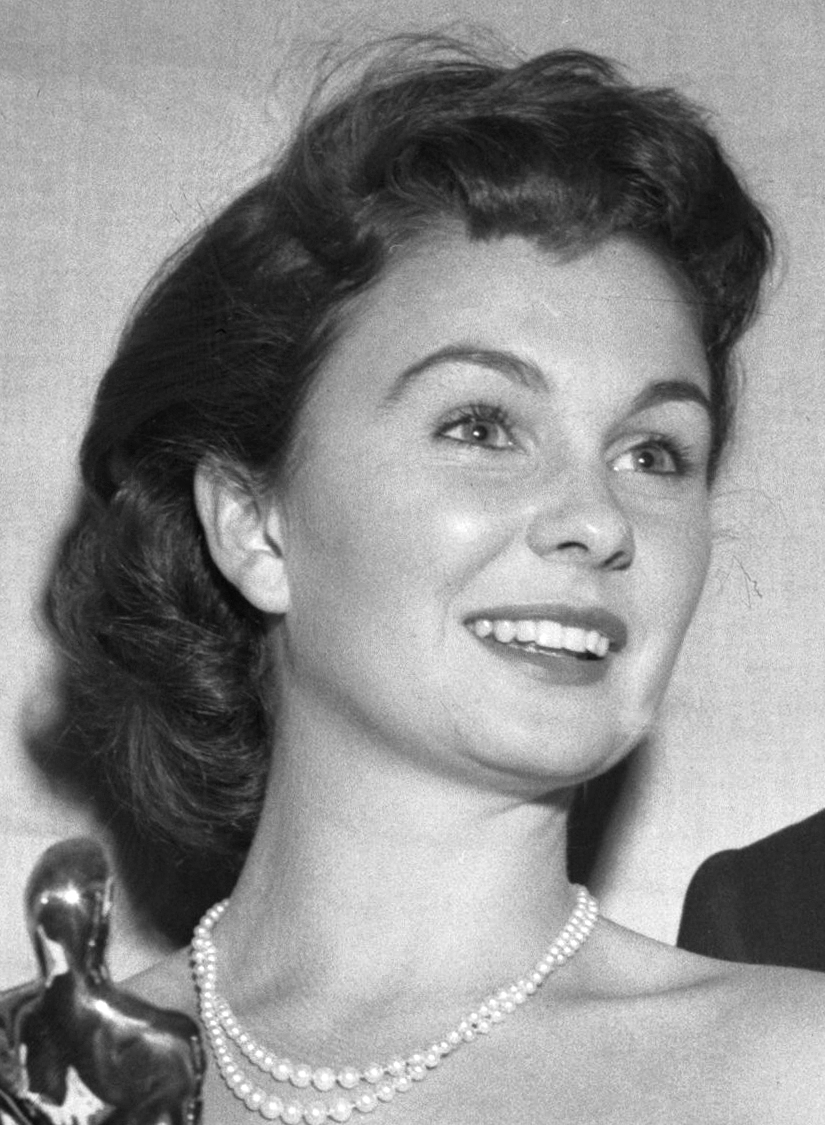
Simmons achieved stardom in Britain with her portrayal of the young Estella in David Lean's acclaimed 1946 adaptation of Great Expectations. The film became the third-most-popular at the British box office in 1947, and Simmons garnered excellent reviews for her performance. The experience on Great Expectations profoundly influenced her, shifting her perspective on acting from a mere "lark" to a serious career pursuit, as she stated, "It was working with David Lean that convinced me to go on." Her rising popularity was evident as she was voted the fourth-most popular star in Britain in 1950.
2. Career in Film and Television
Jean Simmons's extensive career spanned both British and Hollywood cinema, evolving through various genres and culminating in acclaimed television work.
2.1. British Film Career
Following her breakthrough in Great Expectations, Simmons continued to build her career in Britain with a series of significant roles. She appeared in supporting capacities in Hungry Hill (1947) alongside Margaret Lockwood and in the Powell and Pressburger film Black Narcissus (1947), where she played an Indian woman named Kanchi, starring opposite Sabu.
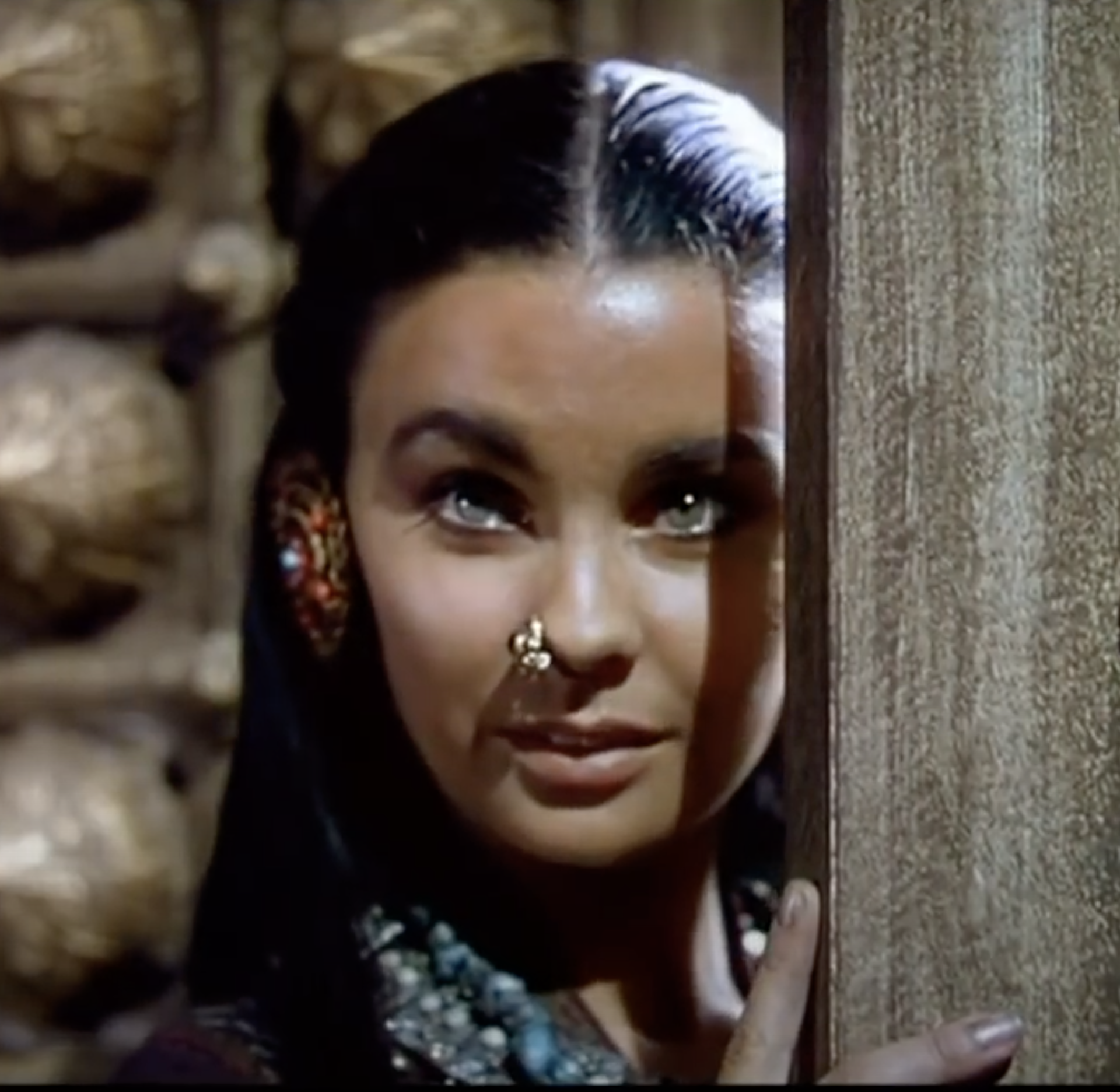
Simmons received her first top billing in the 1947 drama Uncle Silas, followed by The Woman in the Hall (1947). While neither of these films achieved significant commercial success, Simmons soon starred in a huge international hit, portraying Ophelia in Laurence Olivier's 1948 adaptation of Hamlet. Her performance earned her the Volpi Cup for Best Actress at the Venice Film Festival and her first Academy Award for Best Supporting Actress nomination. Olivier offered her the opportunity to work and study at the Old Vic, encouraging her to take on any role for experience, but her contract with the J. Arthur Rank Organisation prevented this.
In 1949, Simmons took the lead in Frank Launder's The Blue Lagoon, a project based on the 1908 novel by Henry De Vere Stacpoole. This film, co-produced with Launder's partner Sidney Gilliat, proved to be a considerable financial success. Simmons also starred with Stewart Granger in the 1949 comedy Adam and Evelyne, which was her first adult role and led to their romantic involvement and eventual marriage. She further solidified her local box office appeal with films like So Long at the Fair (1950) with Dirk Bogarde and Trio (1950), followed by Cage of Gold (1950) and The Clouded Yellow (1950). By 1950, she was recognized as the fourth-most popular star in Britain.
2.2. Hollywood Transition and Major Roles
Simmons's career trajectory shifted significantly when her husband, Stewart Granger, became a Hollywood star with King Solomon's Mines (1950) and signed a contract with MGM. This led Simmons to move to Los Angeles with him. In 1951, the J. Arthur Rank Organisation sold her contract to Howard Hughes, who at the time owned RKO Pictures.
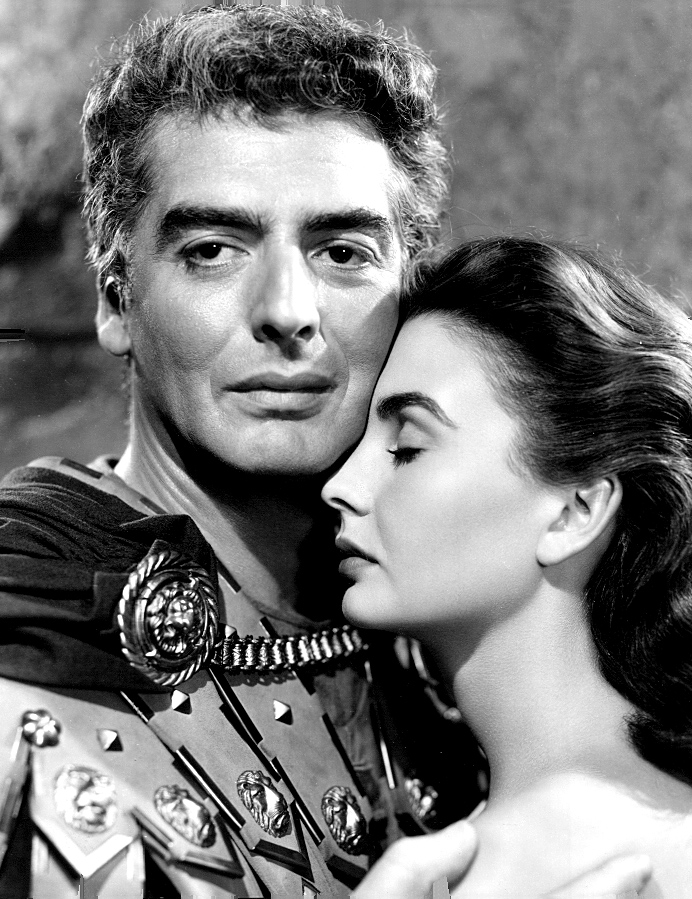
Hughes attempted to initiate a romantic relationship with Simmons, but Granger intervened, warning Hughes off. In retaliation, Hughes deliberately obstructed Simmons's career, notably refusing to lend her to Paramount Pictures for William Wyler's film Roman Holiday, a role that subsequently launched Audrey Hepburn to stardom. Hughes also instructed director Otto Preminger to treat Simmons harshly during the filming of Angel Face (1953), leading costar Robert Mitchum to famously punch Preminger in defense of Simmons. Additionally, Hughes forced her into films like She Couldn't Say No (1954), a comedy also starring Mitchum.
In 1952, Simmons successfully litigated to free herself from her contract with Hughes. The out-of-court settlement required her to make one more film for no additional pay and three more movies under RKO's auspices but filmed elsewhere, while RKO gained the services of Victor Mature for one film.
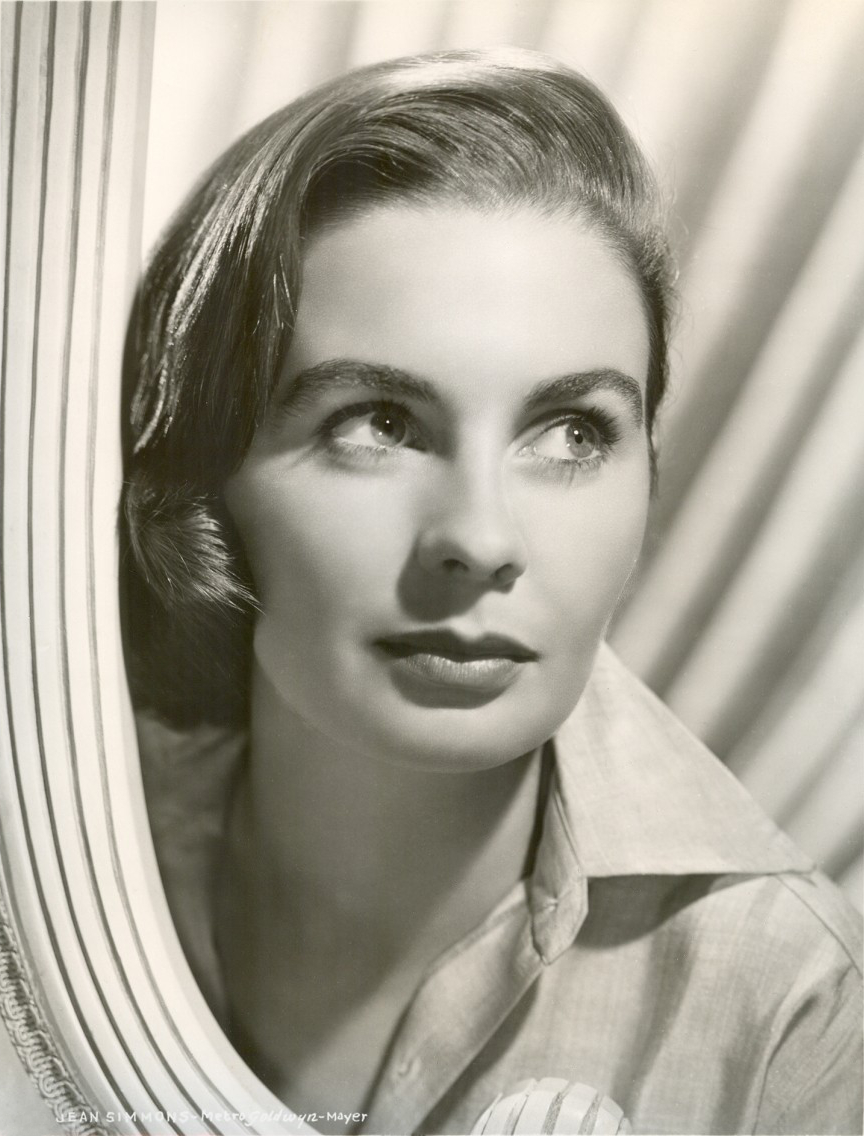
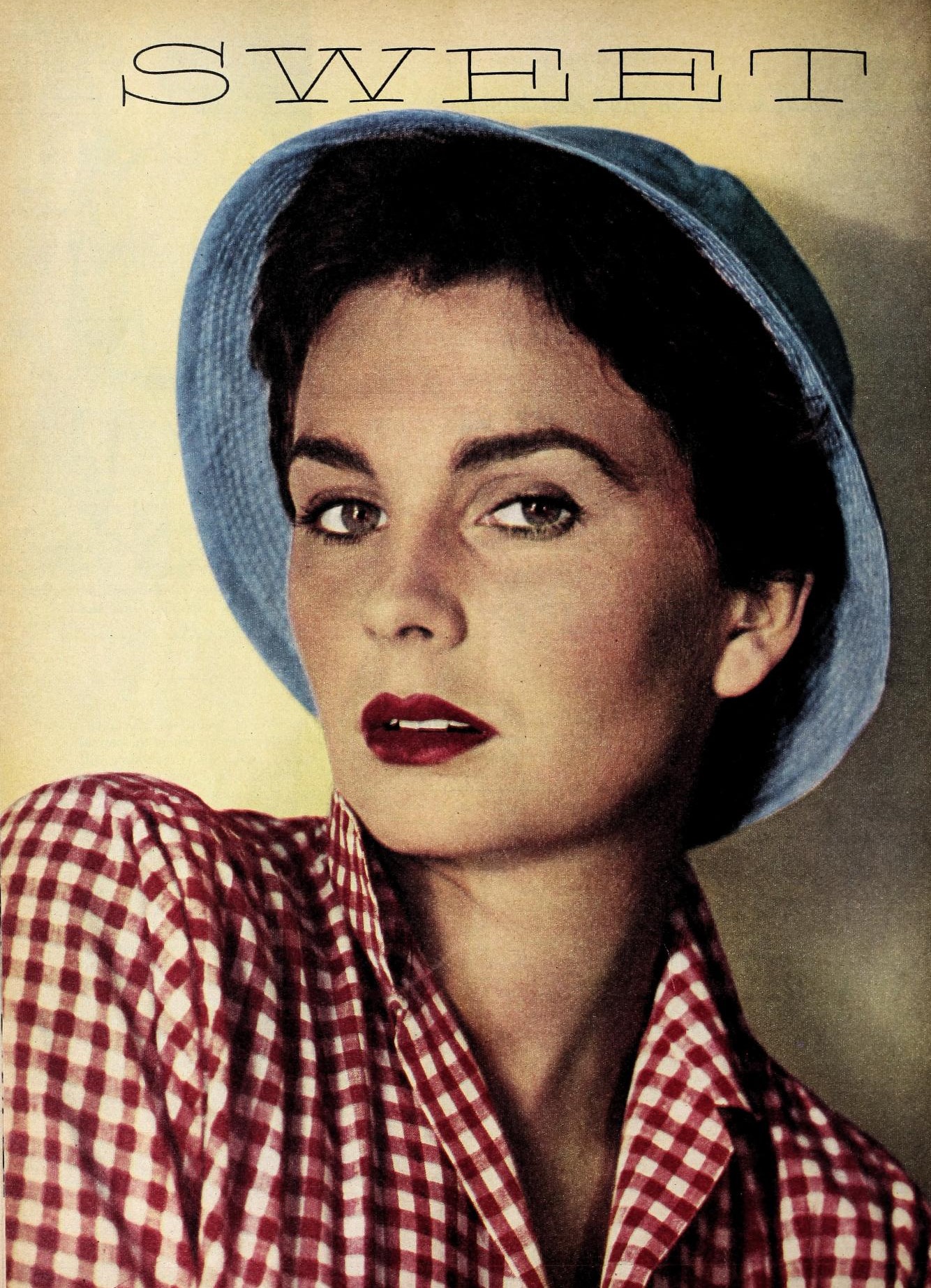
MGM cast her as a young Queen Elizabeth I in Young Bess (1953), again alongside Granger. She fulfilled her obligation to Hughes with the RKO film Affair with a Stranger (1953) co-starring Victor Mature, which was a commercial failure.
Twentieth Century Fox brought her back for the epic The Egyptian (1954), which did not achieve significant popularity. She then took the lead in Columbia's A Bullet Is Waiting (1954). More widely seen was Désirée (1954), where Simmons played Désirée Clary opposite Marlon Brando as Napoleon Bonaparte.
Simmons and Granger briefly returned to England for the thriller Footsteps in the Fog (1955). Her career highlight during this period was her role as Sergeant Sarah Brown opposite Marlon Brando in Joseph Mankiewicz's 1955 screen adaptation of Guys and Dolls. Simmons performed her own singing in the film, a role previously turned down by Grace Kelly, and it became a major box office success, earning Simmons a Golden Globe Award for Best Actress - Motion Picture Musical or Comedy.
Subsequent films like Hilda Crane (1956), This Could Be the Night (1957), and Until They Sail (1957) at MGM were box-office disappointments. However, Simmons found significant success in 1958 with The Big Country, directed by William Wyler. She followed this with acclaimed performances in Home Before Dark (1958) at Warner Bros., described by film critic Philip French as "perhaps her finest performance as a housewife driven into a breakdown," and This Earth Is Mine (1959) with Rock Hudson at Universal.
Her collaboration with director Richard Brooks, whom she would later marry, began with Elmer Gantry (1960), which was a success. She then starred in Spartacus (1960), playing the love interest of Kirk Douglas's character, and The Grass Is Greener (1960) with Mitchum, Cary Grant, and Deborah Kerr.
2.3. Later Film and Television Work
After taking a few years off from the screen, Simmons returned in All the Way Home (1963) with Robert Preston. Her later film credits included Life at the Top (1965) with Laurence Harvey, Mister Buddwing (1966) with James Garner, Divorce American Style (1967) with Dick Van Dyke, and Rough Night in Jericho (1967) with George Peppard and Dean Martin. She appeared in the 1968 television film Heidi. Her second Academy Award nomination for Best Actress came for her role in The Happy Ending (1969), which was written and directed by Richard Brooks.
By the 1970s, Simmons shifted her career focus increasingly towards stage and television acting. She toured the United States in Stephen Sondheim's musical A Little Night Music before bringing the show to London, originating the role of Desirée Armfeldt in the West End. She performed in the show for three years, expressing her enduring appreciation for Sondheim's music, stating, "No matter how tired or 'off' you felt, the music would just pick you up."
In 1983, Simmons gained widespread acclaim for her portrayal of Fiona "Fee" Cleary, the matriarch of the Cleary family, in the popular miniseries The Thorn Birds, for which she won an Emmy Award. She continued her significant television work, appearing in North and South (1985-86) as Clarissa Main, again playing a family matriarch. She also starred in The Dawning (1988) with Anthony Hopkins and Hugh Grant. In 1989, Simmons guest-starred as murder mystery author Eudora McVeigh Shipton, a self-proclaimed rival to Jessica Fletcher, in the two-part Murder, She Wrote episode "Mirror, Mirror, On the Wall" with Angela Lansbury.
The 1990s and 2000s saw Simmons take on diverse roles, including a remake of Great Expectations in 1989, where she played the role of Miss Havisham, the adoptive mother of Estella, a character she herself had played as a girl earlier in her career. In 1991, she appeared in the Star Trek: The Next Generation episode "The Drumhead" as Rear Admiral Norah Satie, a retired Starfleet admiral and hardened legal investigator. She also portrayed Elizabeth Collins Stoddard/Naomi Collins in the short-lived 1991 revival of the 1960s daytime series Dark Shadows, roles originally played by Joan Bennett. From 1994 to 1998, Simmons served as the narrator for the A&E Network documentary television series Mysteries of the Bible. Her later film appearances included How to Make an American Quilt (1995) with Winona Ryder, Maya Angelou, Ellen Burstyn, Anne Bancroft, and Alfre Woodard. In 2001, she lent her voice as Council Member 2 in Final Fantasy: The Spirits Within. In 2004, she voiced the lead role of Old Sophie in the English dub of the animated film Howl's Moving Castle. Her final film role was in Shadows in the Sun (2009).
3. Personal Life
Jean Simmons's personal life was marked by two significant marriages to prominent figures in the entertainment industry and her decision to become a US citizen.
3.1. Marriages and Children
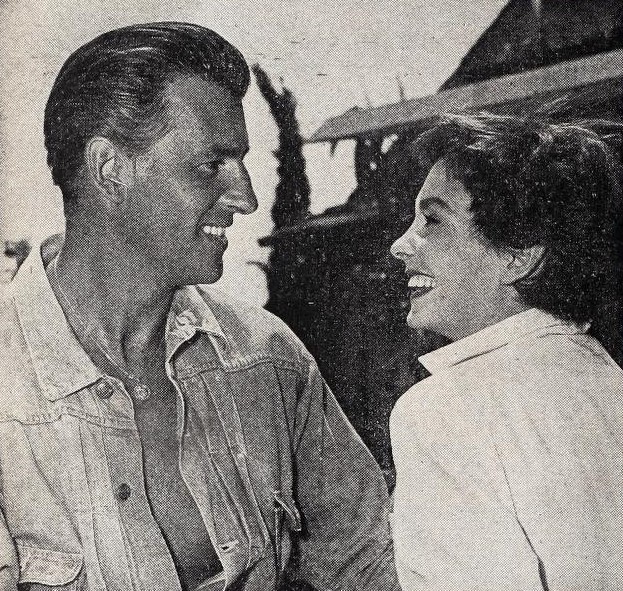
Simmons was married and divorced twice. Her first marriage was to British actor Stewart Granger. They wed in Tucson, Arizona, on 20 December 1950, when she was 21 years old. During their marriage, their daughter, Tracy Granger, was born in 1956. The couple divorced in 1960.
On 1 November 1960, Simmons married her second husband, director Richard Brooks, whom she had worked with on films such as Elmer Gantry and The Happy Ending. Their daughter, Kate Brooks, was born in 1961. Simmons and Brooks's marriage lasted until their divorce in 1980.
Both Granger and Brooks were significantly older than Simmons, a fact she often addressed. She refuted suggestions that she sought a father figure, noting, "They were really nothing like my father at all. My father was a gentle, softly spoken man. My husbands were both much noisier and much more opinionated... it's really nothing to do with age... it's to do with what's there - the twinkle and sense of humor." She also shared insights into her marriages, explaining that Granger wanted her to "be pretty," while Brooks encouraged her to "act!" and "never be afraid to fail," pushing her towards greater independence. Her daughters, Tracy Granger (a film editor) and Kate Brooks (a TV production assistant and producer), were reportedly named in part due to Simmons's friendship with actors Spencer Tracy and Katharine Hepburn.
3.2. Citizenship and Later Life
In 1956, Simmons and Stewart Granger both became US citizens. Although she obtained US citizenship, she did not renounce her British citizenship. In the late 1970s, Simmons moved to the East Coast of the United States, briefly owning a home in New Milford, Connecticut. Later in her life, she returned to California, settling in Santa Monica, California, where she resided until her death.
4. Social Activism and Philanthropy
Beyond her acting career, Jean Simmons was involved in various social causes, notably focusing on human rights and drug-related issues. In 2003, she became a patron of the British charity "Release", an organization dedicated to drugs and human rights. Her commitment to social justice was further demonstrated in 2005 when she signed a petition addressed to then-British Prime Minister Tony Blair. The petition urged Blair not to reclassify cannabis from a Class C to a Class B drug, indicating her public stance on drug policy.
5. Death
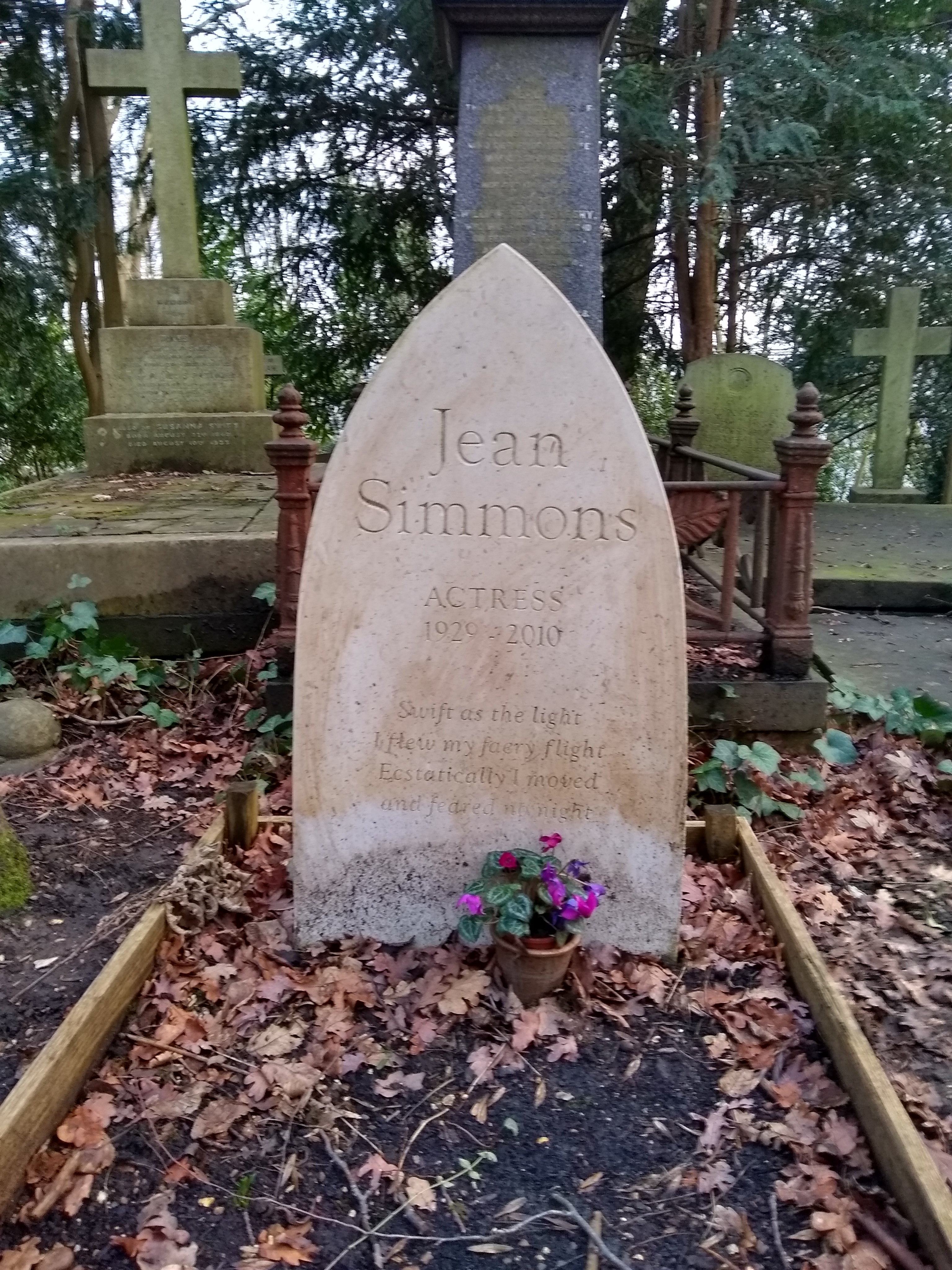
Jean Simmons died from lung cancer at her home in Santa Monica, California, on 22 January 2010, just nine days before what would have been her 81st birthday. Her passing marked the end of a long and impactful career. She was interred in Highgate Cemetery in north London, her final resting place in her home country.
6. Legacy and Recognition
Jean Simmons's legacy is defined by her enduring contributions to cinema and television, marked by numerous accolades and consistent critical praise for her versatile performances.
6.1. Awards and Honors
Simmons received significant recognition throughout her career, earning nominations and awards from prestigious institutions:
| Year | Association | Category | Nominated Work | Result |
|---|---|---|---|---|
| 1949 | Academy Awards | Best Supporting Actress | Hamlet | Nominated |
| 1948 | Venice Film Festival | Volpi Cup for Best Actress | Hamlet | Won |
| 1950 | Bambi Award | Best Actress - International (2nd place) | So Long at the Fair / Trio | Won |
| 1953 | National Board of Review | Best Actress | The Actress / The Robe / Young Bess | Won |
| 1956 | Golden Globe Awards | Best Actress - Motion Picture Musical or Comedy | Guys and Dolls | Won |
| 1957 | BAFTA Awards | Best Foreign Actress | Guys and Dolls | Nominated |
| 1958 | Golden Globe Awards | Best Actress - Motion Picture Musical or Comedy | This Could Be the Night | Nominated |
| 1959 | Laurel Awards | Top Female Dramatic Performance (4th place) | Home Before Dark | Won |
| 1959 | Golden Globe Awards | Best Actress - Motion Picture Drama | Home Before Dark | Nominated |
| 1961 | Laurel Awards | Top Female Dramatic Performance (3rd place) | Elmer Gantry | Won |
| 1961 | BAFTA Awards | Best Foreign Actress | Elmer Gantry | Nominated |
| 1961 | Golden Globe Awards | Best Actress - Motion Picture Drama | Elmer Gantry | Nominated |
| 1961 | Laurel Awards | Top Female Comedy Performance (5th place) | The Grass Is Greener | Won |
| 1970 | Academy Awards | Best Actress | The Happy Ending | Nominated |
| 1970 | Golden Globe Awards | Best Actress - Motion Picture Drama | The Happy Ending | Nominated |
| 1983 | Primetime Emmy Awards | Outstanding Supporting Actress in a Miniseries or a Movie | The Thorn Birds | Won |
| 1984 | Golden Globe Awards | Best Supporting Actress - Series, Miniseries or Television Film | The Thorn Birds | Nominated |
| 1989 | Primetime Emmy Awards | Outstanding Guest Actress in a Drama Series | Murder, She Wrote | Nominated |
| 1996 | Screen Actors Guild Awards | Outstanding Performance by a Cast in a Motion Picture | How to Make an American Quilt | Nominated |
In the 2003 New Year Honours, Jean Simmons was appointed an Officer of the Order of the British Empire (OBE) for her services to acting, a distinguished honor from her home country.
6.2. Critical Reception and Impact
Jean Simmons was widely celebrated for her remarkable versatility as an actress, capable of transitioning seamlessly between dramatic, musical, and comedic roles. Her ability to embody a diverse range of characters, from the innocent Estella in Great Expectations to the complex Charlotte Bronn in Home Before Dark and the spirited Sarah Brown in Guys and Dolls, left a significant mark on the film industry. Critics frequently lauded her captivating screen presence and depth of performance, solidifying her status as one of the most respected actresses of her generation. Her lasting impact is reflected in the enduring popularity of her films and her recognition as a celebrated British actress who successfully navigated the challenging landscape of both British and Hollywood cinema.
7. Filmography
| Year | Film / Television / Stage | Role | Notes |
|---|---|---|---|
| 1944 | Give Us the Moon | Heidi | |
| 1944 | Mr. Emmanuel | Sally Cooper | Billed as Jean Simmonds |
| 1944 | Sports Day | Peggy | |
| 1945 | Kiss the Bride Goodbye | Molly Dodd | |
| 1945 | Meet Sexton Blake | Eva Watkins | |
| 1945 | The Way to the Stars | A singer | |
| 1945 | Caesar and Cleopatra | Harpist | Uncredited |
| 1946 | Great Expectations | Estella as a girl | |
| 1947 | Hungry Hill | Jane Brodrick | |
| 1947 | Black Narcissus | Kanchi | |
| 1947 | Uncle Silas | Caroline Ruthyn | |
| 1947 | The Woman in the Hall | Jay Blake | |
| 1948 | Hamlet | Ophelia | Won Volpi Cup for Best Actress; Nominated - Academy Award for Best Supporting Actress |
| 1949 | Adam and Evelyne | Evelyne Kirby | |
| 1949 | The Blue Lagoon | Emmeline Foster | |
| 1950 | So Long at the Fair | Vicky Barton | Won Bambi Award for Best Actress - International (2nd place) |
| 1950 | Trio | Evie Bishop | Segment "Sanatorium"; Won Bambi Award for Best Actress - International (2nd place) |
| 1950 | Cage of Gold | Judith Moray | |
| 1950 | The Clouded Yellow | Sophie Malraux | |
| 1952 | Androcles and the Lion | Lavinia | |
| 1953 | Angel Face | Diane Tremayne Jessup | |
| 1953 | Young Bess | Princess Elizabeth | Won National Board of Review Award for Best Actress (also for The Robe and The Actress) |
| 1953 | Affair with a Stranger | Carolyn Parker | |
| 1953 | The Robe | Diana | Won National Board of Review Award for Best Actress (also for Young Bess and The Actress) |
| 1953 | The Actress | Ruth Gordon Jones | Won National Board of Review Award for Best Actress (also for Young Bess and The Robe) |
| 1954 | She Couldn't Say No | Corby Lane | AKA Beautiful but Dangerous |
| 1954 | The Egyptian | Meryt | |
| 1954 | A Bullet Is Waiting | Cally Canham | |
| 1954 | Désirée | Désirée Clary | |
| 1954 | Demetrius and the Gladiators | Diana | Appeared in a clip from The Robe |
| 1955 | Footsteps in the Fog | Lily Watkins | |
| 1955 | Guys and Dolls | Sergeant Sarah Brown | Won Golden Globe Award for Best Actress - Motion Picture Musical or Comedy; Nominated - BAFTA Award for Best Foreign Actress |
| 1956 | Hilda Crane | Hilda Crane Burns | |
| 1957 | This Could Be the Night | Anne Leeds | Nominated - Golden Globe Award for Best Actress - Motion Picture Musical or Comedy |
| 1957 | Until They Sail | Barbara Leslie Forbes | |
| 1958 | The Big Country | Julie Maragon | |
| 1958 | Home Before Dark | Charlotte Bronn | Won Laurel Award for Top Female Dramatic Performance (4th place); Nominated - Golden Globe Award for Best Actress - Motion Picture Drama |
| 1959 | This Earth Is Mine | Elizabeth Rambeau | |
| 1960 | Elmer Gantry | Sharon Falconer | Won Laurel Award for Top Female Dramatic Performance (3rd place); Nominated - BAFTA Award for Best Foreign Actress; Nominated - Golden Globe Award for Best Actress - Motion Picture Drama |
| 1960 | Spartacus | Varinia | |
| 1960 | The Grass Is Greener | Hattie Durant | Won Laurel Award for Top Female Comedy Performance (5th place) |
| 1963 | All the Way Home | Mary Follett | |
| 1965 | Life at the Top | Susan Lampton | |
| 1966 | Mister Buddwing | The Blonde | |
| 1967 | Divorce American Style | Nancy Downes | |
| 1967 | Rough Night in Jericho | Molly Lang | |
| 1968 | Heidi | Fräulein Rottenmeier | TV film |
| 1969 | The Happy Ending | Mary Wilson | Nominated - Academy Award for Best Actress; Nominated - Golden Globe Award for Best Actress - Motion Picture Drama |
| 1971 | Say Hello to Yesterday | Woman | |
| 1972 | The Odd Couple | Princess Lydia | Episode: "The Princess" |
| 1975 | Mr. Sycamore | Estelle Benbow | |
| 1975 | The Easter Promise | Constance Payne | TV film |
| 1977 | Hawaii Five-O | Terri O'Brien | TV; Episode "A Cop on the Cover" |
| 1978 | The Dain Curse | Aaronia Haldorn | TV miniseries |
| 1978 | Dominique | Dominique Ballard | |
| 1979 | Beggarman, Thief | Gretchen Jordache Burke | TV film |
| 1981 | A Small Killing | Margaret Lawrence | TV film |
| 1981 | Golden Gate | Jane Kingsley | TV film |
| 1981 | Jacqueline Susann's Valley of the Dolls | Helen Lawson | TV film |
| 1983 | The Thorn Birds | Fee Cleary | TV miniseries; Won Primetime Emmy Award for Outstanding Supporting Actress in a Miniseries or a Movie; Nominated - Golden Globe Award for Best Supporting Actress - Series, Miniseries or Television Film |
| 1984 | December Flower | Etta Marsh | TV film |
| 1984 | All for Love | Deidre Mackay | Episode: "Down at the Hydro" |
| 1985 | Midas Valley | Molly Hammond | TV film |
| 1985 | North and South | Clarissa Gault Main | TV miniseries |
| 1986 | North and South Book II | Clarissa Gault Main | TV miniseries |
| 1987 | Perry Mason: The Case of the Lost Love | Laura Robertson | TV film |
| 1988 | Inherit the Wind | Lucy Brady | TV film |
| 1988 | The Dawning | Aunt Mary | |
| 1988 | Going Undercover | Maxine de la Hunt | Released as Going Undercover in the US in 1988; Straight to video in the UK as Yellow Pages (completed 1985) |
| 1989 | Great Expectations | Miss Havisham | TV miniseries |
| 1989 | Murder, She Wrote | Eudora McVeigh Shipton | Episode: "Mirror, Mirror on the Wall"; Nominated - Primetime Emmy Award for Outstanding Guest Actress in a Drama Series |
| 1991 | Star Trek: The Next Generation | Rear Admiral Norah Satie | Episode: "The Drumhead" |
| 1991 | Dark Shadows | Elizabeth Collins Stoddard / Naomi Collins | |
| 1991 | They Do It with Mirrors | Carrie-Louise Serrocold | TV film; Miss Marple (TV series) |
| 1994 | In the Heat of the Night | Miss Cordelia | TV; Episode: "Ches and the Grand Lady" |
| 1994-1998 | Mysteries of the Bible | Narrator | Documentary television series |
| 1995 | How to Make an American Quilt | Em Reed | Nominated - Screen Actors Guild Award for Outstanding Performance by a Cast in a Motion Picture |
| 1995 | Daisies in December | Katherine Palmer | TV film |
| 2001 | Final Fantasy: The Spirits Within | Council Member 2 | Voice role |
| 2003 | Winter Solstice | Countess Lucinda Rhives | Released in Germany as Wintersonne |
| 2004 | Jean Simmons: Rose of England | Herself | Documentary |
| 2004 | Howl's Moving Castle | Old Sophie | Voice role, English version |
| 2005 | Thru the Moebius Strip | Shepway | Voice role |
| 2009 | Shadows in the Sun | Hannah | Final film role |